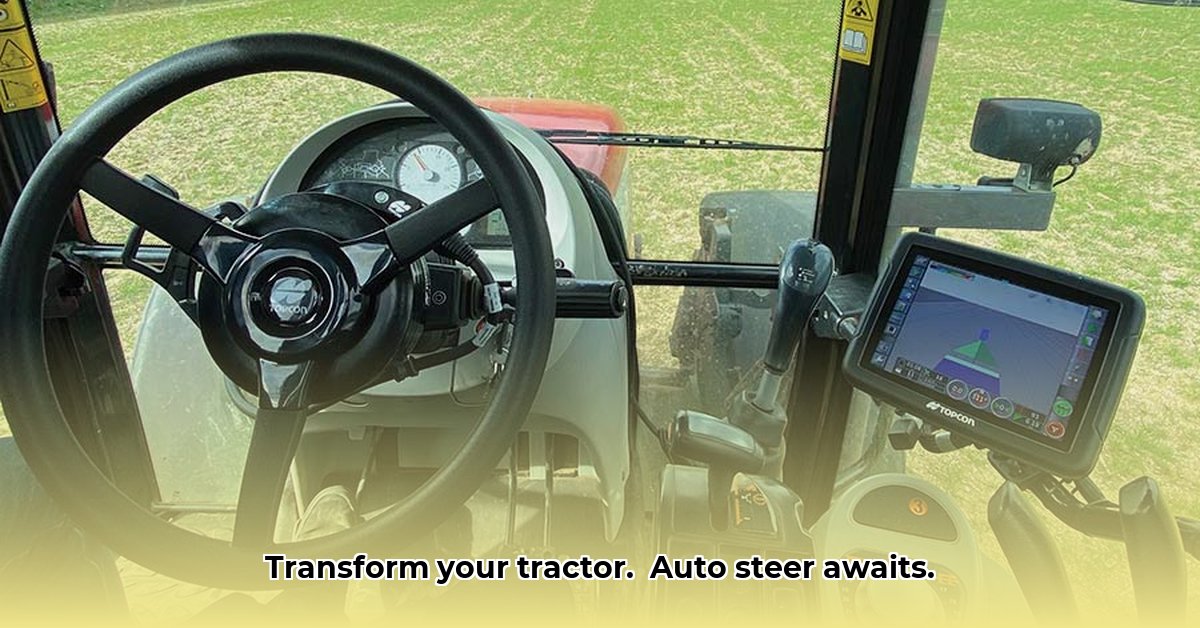
Auto Steer for Older Tractors: A Practical Guide to Modernizing Your Farm
Tired of wrestling with your older tractor's steering? Modern, affordable auto-steer systems can transform how you work, making your tractor more precise and efficient. This guide will walk you through the process of choosing and installing an auto-steer system, even for older models. Whether you're a seasoned farmer or just starting out, we'll show you how to get the most from your equipment with these clever technologies. For more in-depth information, check out this comprehensive guide.
Understanding Auto-Steer Technology: GPS Guidance for Your Tractor
Auto-steer uses GPS (Global Positioning System) technology to pinpoint your tractor's location in the field. This data is then used to control the steering, keeping you on a pre-determined path. This precision significantly reduces overlaps, saving you time, fuel, and valuable resources such as seeds and fertilizer. Imagine straight lines, fewer overlaps, and less wasted effort. That’s the power of auto-steer! Isn't that a considerable time saver?
Many systems use RTK (Real-Time Kinematic) technology for even greater accuracy, often down to a few centimeters. RTK usually requires a base station (a fixed GPS receiver) or a subscription to a correction signal service, dramatically increasing precision. This level of accuracy is especially beneficial for tasks like spraying or planting. What level of accuracy do you need for your specific operations?
Top Auto-Steer Systems: A Detailed Comparison
Choosing the right system depends on your budget and the level of accuracy you require. Let's compare three popular and relatively affordable options:
| System | Price Range | Accuracy | Tractor Compatibility | Installation Difficulty | Pros | Cons |
|---|---|---|---|---|---|---|
| AgJunction Wheelman | $2,000 - $4,000 | +/- 2-3 inches | Wide range of tractors | Relatively Easy | Affordable, user-friendly, often requires minimal installation | Lower accuracy than RTK systems; potential compatibility issues with very old tractors |
| FieldBee (Manual Guidance) | $1,500 - $3,000 | +/- 4-6 inches | Most tractors | Relatively Easy | Inexpensive, simple setup; good for smaller fields or less demanding tasks | Lower accuracy than RTK, requires more active driver input and attention |
| FieldBee (RTK) | $3,000 - $5,000 | +/- 1-2 inches | Most tractors | Moderate | High accuracy; ideal for precise applications (e.g., spraying) | Requires a reliable internet connection or a base station; higher cost |
| Outback Guidance's Rebel | $3,000 - $6,000 | +/- 1-2 inches | Varies | Can require professional | Superior accuracy and features; excellent support | Highest cost, installation might need a professional; compatibility depends on the tractor |
Note: Price ranges are estimates and may vary depending on your specific configuration and retailer. Always check for compatibility with your tractor model before purchasing.
Choosing the Right Auto-Steer System for Your Needs
Selecting the best system is a crucial step. Consider these factors:
- Budget: How much can you realistically invest?
- Accuracy Requirements: Do you need pinpoint accuracy (for spraying, specialized planting) or is moderate accuracy sufficient?
- Tractor Compatibility: Check the manufacturer’s website for a list of compatible models.
- Technical Skills: Are you comfortable with installation or would you prefer professional help?
- Internet Connectivity: Some RTK systems require a stable internet connection or a base station – check your connection reliably.
Risk Assessment Matrix
This matrix highlights potential challenges:
| System | Accuracy Risk | Compatibility Risk | Cost Risk | Connectivity Risk | Installation Risk |
|---|---|---|---|---|---|
| AgJunction Wheelman | Moderate | Moderate | Low | Low | Low |
| FieldBee (Manual Guidance) | Low | Low | Low | Low | Low |
| FieldBee (RTK) | Low | Low | Moderate | Moderate | Moderate |
| Outback Guidance's Rebel | Low | Moderate | High | Moderate | Moderate to High |
Interpreting the Matrix: "Low" risk suggests a minor potential problem, "High" risk indicates greater potential challenges. This is a guideline; actual risk depends on your specific situation and skills.
Installation and Setup: A Smoother Transition
Installation varies by system and tractor. Simpler systems may be DIY-friendly, while others might need professional assistance, especially for older models. Always consult the manufacturer's instructions. Professional installation ensures correct and safe setup, crucial for optimal performance.
Maintenance and Troubleshooting: Keeping Your System Running Smoothly
Regular maintenance is key. This includes:
- Software Updates: Keep your software current.
- Antenna Checks: Ensure your GPS antenna is securely mounted and unobstructed.
- Connection Checks: Regularly inspect wiring and connections for damage or looseness.
- Calibration: Periodic recalibration might be needed to maintain accuracy.
Most systems offer online troubleshooting and support. However, complex issues might require manufacturer assistance or a qualified technician.
Reap the Rewards of Precision Farming
Auto-steer systems offer a significant return on investment. Expect improved efficiency, reduced fuel consumption, and less waste of valuable resources. With several affordable options available, precision farming is now within reach for many more farmers. Make a smart decision, upgrade your older tractor and watch your farm's productivity and profitability flourish.
Key Takeaways
- Auto-steer boosts efficiency and reduces input costs.
- System choice depends on budget, compatibility, and desired accuracy.
- GPS or RTK offers different accuracy and cost levels.
- Consider installation complexity, maintenance, and data security.
- Professional installation is often recommended for older tractors.